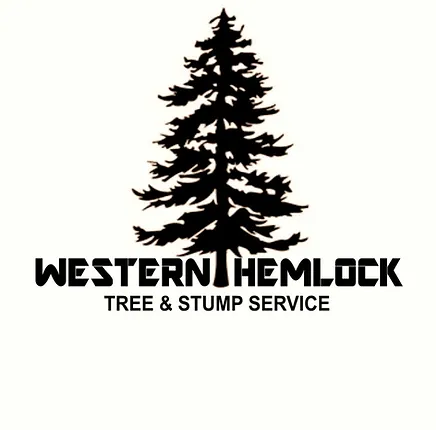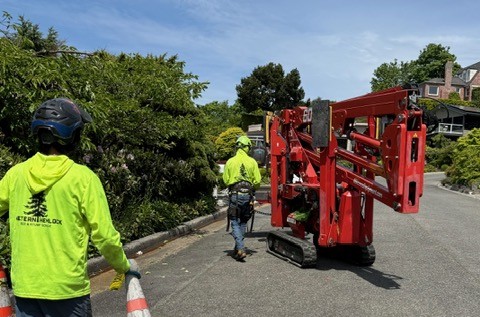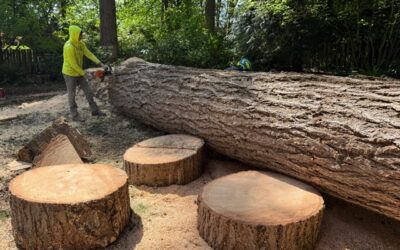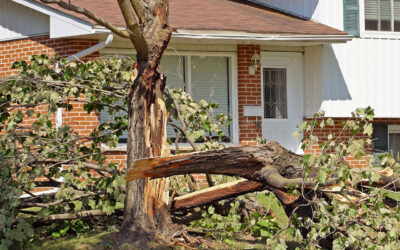Trees are an important part of your property—they add beauty, shade, and value to your home. But when a tree becomes unstable or diseased, it can pose a serious safety risk to your family, your house, and even your neighbors. At Western Hemlock Tree & Stump, we help homeowners across Snohomish County make informed decisions about their trees.
So how do you know when it’s time to say goodbye to a tree? Below are seven of the most common signs a tree needs to be removed—plus expert advice on what to do next.
1. The Tree Is Leaning Suddenly or Severely
A slight lean in a mature tree can be natural—but a tree that suddenly begins to tilt after wind or rain is a red flag. This may indicate root failure or a shifting foundation. In areas like Bothell, Mill Creek, and Lake Stevens, we frequently see this after winter storms or prolonged rain.
If the lean is more than 15 degrees, especially in a direction where it could fall on people or structures, removal is usually the safest option. Our emergency tree removal team is available when urgent action is needed.
2. You See Large Dead Branches (a.k.a. Widowmakers)
Dead or broken branches high in a tree can fall unexpectedly—especially in windy conditions. These branches, often called “widowmakers,” are extremely dangerous. If more than 25% of the canopy is dead or dying, the tree may be in decline.
While trimming dead limbs can sometimes help, repeated dieback often means internal rot or root damage. A certified arborist in Snohomish County can diagnose the cause and recommend removal if needed.
3. Trunk Cavities, Cracks, or Rot
The trunk is the structural core of the tree. If you notice large vertical cracks, hollow sections, or oozing sap, it’s a sign of internal decay. Fungi or mushrooms growing at the base of the trunk may also indicate a rotting interior.
While minor cavities can sometimes be monitored, extensive trunk damage compromises stability and usually requires professional removal to prevent collapse.
4. Signs of Disease or Infestation
Diseased trees often show early signs like leaf loss, strange coloring, cankers, bark shedding, or insect infestations. Invasive species like bark beetles and root rot fungi can destroy the health of even mature trees quickly.
If you suspect disease, don’t delay. Our ISA Certified Arborists offer tree health evaluations across Everett, Mukilteo, and surrounding areas to determine whether the tree can be treated—or needs to come down.
5. The Tree is Growing Too Close to Structures
It’s common to see trees planted too close to homes, fences, garages, or power lines. As roots expand and branches grow, they can interfere with foundations, roofing, and electrical service. Trees rubbing against siding or hanging over roofs also attract pests.
Sometimes we can resolve this with tree cabling and bracing or selective trimming. But in many cases, full removal is the most effective and cost-efficient solution long-term.
6. Root Damage or Soil Heaving
Check the base of your tree—are roots exposed, cracked, or breaking through the soil? Are sidewalks or patios lifting nearby? Root damage destabilizes trees, especially in heavy winds or saturated ground conditions.
This is common in areas with compacted soil or post-construction stress. We offer inspections to determine if root pruning or full removal is necessary.
7. The Tree is Already Dead
Once a tree has fully died, it becomes brittle and unstable. Dead trees no longer have the flexibility to withstand winds or storms, making them one of the most dangerous structures on your property.
We strongly recommend removing dead trees before they fall unexpectedly. Our dead tree removal service ensures safe, efficient removal with minimal disruption to your yard.
Bonus: When Trees Become Liability Risks
In addition to safety concerns, trees that pose a risk to neighboring properties or public roads can become insurance and liability issues. If you’ve received a notice from a utility company or your HOA, schedule a professional evaluation to avoid legal complications.
What to Do If You’re Unsure
If you’re not sure whether your tree needs to be removed, the best first step is a professional evaluation. At Western Hemlock Tree & Stump, our ISA-certified arborists will inspect the tree, assess its condition, and provide an honest recommendation.
We serve homeowners and property managers across Snohomish County, including Everett, Bothell, Mill Creek, Lake Stevens, and beyond.
📞 Ready for a Tree Inspection?
We offer free, no-pressure consultations and quotes. If your tree is unsafe, unstable, or dead, we’ll remove it safely and efficiently—with stump grinding and cleanup included if needed.
Call 425-374-8996 or request a free quote online.
Related Services
Frequently Asked Questions
How can I tell if a tree is dangerous?
A tree may be dangerous if it’s leaning suddenly, has dead or hanging branches, trunk decay, or exposed roots. Diseased or unstable trees near structures should be evaluated by a certified arborist.
Can a leaning tree be saved?
Some slightly leaning trees can be stabilized with cabling or pruning, but a tree with a sudden or severe lean is often unsafe and may need to be removed.
Should I remove a dead tree immediately?
Yes. Dead trees are structurally unstable and can fall unexpectedly, especially during storms. Prompt removal is recommended to prevent property damage and ensure safety.
What should I do if I’m unsure about a tree’s condition?
Contact a certified arborist for a professional evaluation. Western Hemlock Tree & Stump offers tree health inspections and removal consultations throughout Snohomish County.



